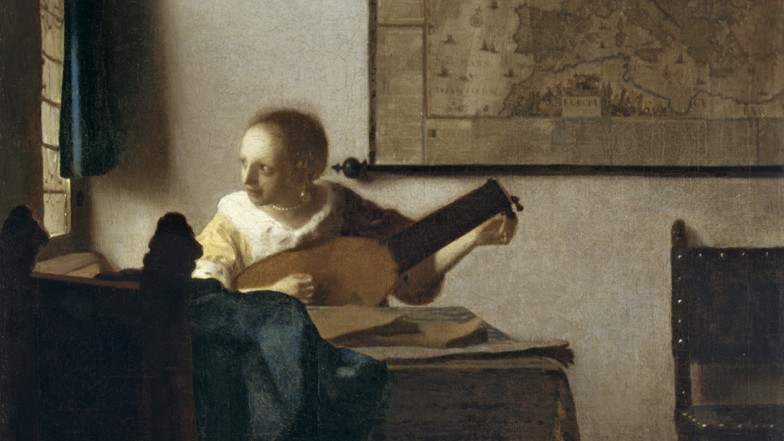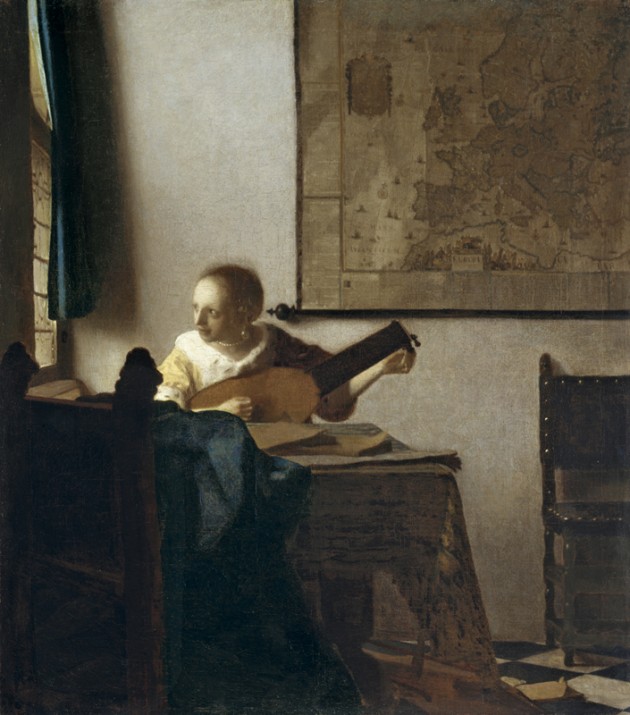Vermeer's "Woman with a Lute" on Loan from the Metropolitan Museum of Art
Economists and statisticians have postulated that Johannes Vermeer painted between 53.7 and 59.8 paintings during his short career, which lasted from around 1656 to 1675. Today, scholars have identified about 36 paintings to be by this revered master’s hand, although that number may not be solid, given questions about condition and attribution. The Metropolitan Museum of Art in New York has the largest cache of Vermeers in America, and on July 8 one of these precious jewels, Woman with a Lute, will be in residence at the Norton Simon Museum. This is the second time in four years that a work by this enigmatic artist has graced these Pasadena galleries, joining other 17th-century masterworks from the Dutch Golden Age. And it will be the first time that this particular painting has traveled as far west as California.
One of Vermeer’s beloved “Pearl Pictures,” Woman with a Lute evokes expectation, longing, and perhaps even mindful restraint or temperance, all in a mere 20 x 18 inches. Familiar objects, such as the remarkable pearl-drop earring that catches the sunlight, the chair with lion-headed finials, the map of Europe and the yellow jacket trimmed in ermine, are carefully and precisely staged in this quiet interior scene. There is no doubt that this lovely musician is the focal point; the large map, the imposing lions’ heads and the signature blue curtains on the leaded window all frame her face, and especially those misty eyes. Vermeer’s muted tones and gauze-like shadows capture a moment in which we can imagine the music stopping long enough for this anticipatory young woman to tune her instrument and perhaps catch the first glimpse of the object of her desire. The sheet music and the silent viola da gamba in the middle foreground hint at a pending duet, as does her look of longing and desire. The map of Europe, however, studded with sailing ships, may be a subtle suggestion that her wait, and the duet itself, may be somewhat delayed.
This intimate corner of a domestic interior is not an unfamiliar one. We have seen before the same leaded window, the same conventional, black-and-white tiled floor, the heavy tapestry draped over the same table, the ubiquitous chair with lion-head finials and similar maps in at least 19 of Vermeer’s extant paintings. Vermeer’s own world is accessible to us 350 years after he inhabited this secure and quiet space, and yet its meaning still manages to remain mysterious, with stories such as this one left unresolved. Were these household props rearranged time after time to relay different stories, much like flowers and fruit in contemporary 17th-century still lifes? Do they hold meaning beyond and deeper than their quotidian purpose? The yellow jacket with ermine trim was listed in the inventory of Vermeer’s possessions after his death, and the paucity of upper-class trappings in this list reveals a household and income that was barely sufficient throughout his lifetime to sustain his wife and 11 children. This seems almost unthinkable now, since his few remaining paintings are today considered priceless.
At the turn of the 19th century and into the 20th, Woman with a Lute was in the collection of millionaire railroad developer Collis P. Huntington, who bequeathed it and numerous other paintings to the Metropolitan Museum of Art. His second wife, Arabella, and her son, Archer, were both given life interest in the painting, but it was passed to the Met in 1925, the year after Arabella’s death. Other paintings from Arabella’s collection now reside at the Norton Simon’s neighboring institution, the Huntington Library, Art Collections and Botanical Gardens in San Marino, which was formed by Arabella and her later husband Henry E. Huntington, Collis’ nephew.
This exhibition is supported by an indemnity from the Federal Council on the Arts and the Humanities.
Featured Media


